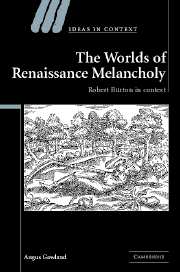Book contents
3 - Melancholy and divinity
Published online by Cambridge University Press: 13 January 2010
Summary
Burton began the final Section of the Anatomy by claiming that religious melancholy was the most widespread and serious form of the disease prevalent in the world, indeed that it ‘more besots and infatuates men … doth more harme, workes more disquietness to mankinde, and hath crucified the soules of mortall men … then warres, plagues, sicknesses, dearth, famine, and all the rest’ (3.331.22–8 [3.4.1.1]). The analysis of religious melancholy reveals the depth and scope of the author's commitment to educate and instil in his readership moral and spiritual virtue, and once again this involved an erudite and eclectic exploration of ancient, medieval, and neoteric texts. However, it is here that the character of the book as a consideration of the pressing issues prompted by the intellectual and political climate of Europe as they were manifested in early Stuart England comes into focus. The problem of religious melancholy in the form with which Burton was concerned had been formulated in continental post-Reformation controversy, and his analysis explicitly drew on its origins. For Burton, it was a disease that had long afflicted every society, both Christian and pagan, but it had now come especially to characterise the condition of his own Church and commonwealth. This brought him into probably the most sensitive domain of Jacobean and Caroline politics. As we shall see, this part of the Anatomy demonstrates the way in which Burton exploited the flexibility of his humanist conceptual resources, and realised the polemical potential of the medical-scientific theory of melancholy, to create a fully fledged political response to the spiritual pathology that he considered to have taken hold in England.
- Type
- Chapter
- Information
- The Worlds of Renaissance MelancholyRobert Burton in Context, pp. 139 - 204Publisher: Cambridge University PressPrint publication year: 2006

